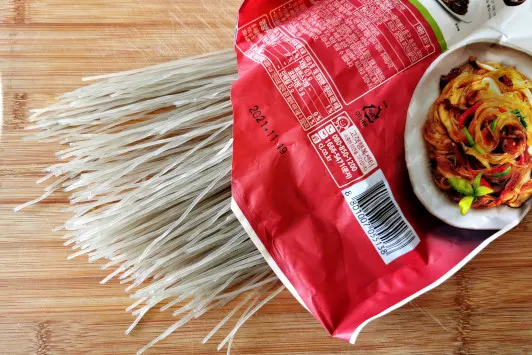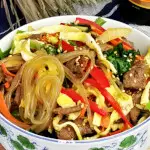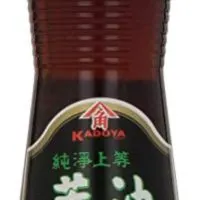What is Japchae? Japchae is Korean stir-fried noodles with a unique texture. It means mixed vegetables in Korean, but besides the colorful vegetables, and the well-seasoned beef, it is the bouncy and slippery sweet potato glass noodles called dangmyeong that set it apart from others. The flavor is very different from the Chinese stir-fried noodles, the Indonesian mee goreng, and the Malaysian char kuey teow. It is in a different league, and you got to try it.
Note: 잡채 is translated as Japchae but is also called chapchae, glass noodles. They all refer to the Korean sweet potato starch noodles stir-fried with vegetables.

Note: This post may contain affiliate links. Please read my privacy policy for more info. I may receive commissions for purchases made through links in this post. As an Amazon Associate, I earn from qualifying purchases.
How to prepare Japchae
I usually start by preparing the beef first, as it takes time to marinate. Then I will cut all the vegetables before stir-frying them. Next, fry the egg, prepare the sauce, and only boil the noodles before mixing up the ingredients.
Let’s look at each step one by one.
1. Marinate the beef
- Cut the beef (I use rib-eye steak) into thin slices. I always keep my chilled beef in the freezer until It is half-frozen since it is easier to slice it thinly in this state.
- Marinate beef in a bowl with minced garlic, sugar, soy sauce, ground black pepper, and toasted sesame oil. Keep it in the refrigerator for at least half an hour before stir-frying to let the flavor infuse into the meat.
Some cooks also marinate the soaked dried mushrooms with the same marinade, but I prefer to stir fry the mushrooms just with salt, not letting the marinade masking the natural aroma of the mushrooms.
2. Prepare other ingredients
For the spinach
- Clean the spinach (use the leaves only) in water thoroughly to remove any dirt and sand.
- Bring a pot of water to a boil and blanch the spinach for 30 seconds.
- Remove it immediately and drain with a colander. When it cools and manageable, squeeze out as much water as possible with your clean hand. Make sure it is dry not to wet the noodles when mixing it with the noodles.
- Season the spinach with some salt, minced garlic, and toasted sesame oil, then set aside.
Dried shiitake mushrooms
Soak the dry shiitake mushroom until soft. It may take about 2 hours or half a day, depending on the mushrooms’ size and thickness. The time can be shortened by soaking in hot water.
When the mushrooms are soft, remove the stem and cut the mushrooms into thin slices.
The vegetables
The main vegetables for japchae recipe are yellow onions, carrots, and red bell pepper.
Cut the onion into thin slices and the carrots and bell pepper into long julienne.
I also cut a stalk of scallion into julienne to be added in the last step of cooking.
3. Stir fry the meat, vegetables, and noodles
All the vegetables should be cooked until it is still a little crunchy to pair well with the soft and chewy noodles.
You can stir-fry all the ingredients or do it separately. Since it is time-consuming to stir fry separately, most of the restaurants will cook them simultaneously. However, it is better to stir fry separately because each vegetable requires a different duration to cook. Also, they will look fresh and preserve its vibrant color.
- Start by stir-frying the item with the lightest color, i.e., the onion and the beef for the last. You do not need to wash the pan to finish cooking, and yet each item is clean by following this order.
- Add some vegetable oil to the pan and saute the onions for about 2 to 3 minutes until they turn translucent. Set aside.
- Add some more oil to the same pan and stir fry the carrots, requiring 3 minutes to soften.
- Continue stir-frying for the bell pepper (1 minute).
- I also season the vegetables with a pinch of salt while stir-frying.
- As for the mushrooms, stir fry until all the water has evaporated.
- Lastly, add some oil to the pan and stir fry the beef until it is no longer pink and the marinade has dry up. It takes only one to two minutes, depending on the amount of meat and the stove’s heat. Remove the beef immediately once it is cooked to keep it tender.
You can cook all the vegetables with sesame oil, but I prefer using oil with neutral flavor for stir-frying for a milder sesame flavor.
4. Make some bright-colored egg strips
Eggs are almost used for all stir fry noodles in every country, with no exception to japchae.
Here are the steps :
- Crack the egg and beat with a pinch of salt.
- Add minimum oil to a clean nonstick pan and pour the beaten eggs to pan fry to form a thin omelet.
- Flip the omelet over low heat to get an omelet with bright yellow. The trick is when the omelet has set, flip it over and turn off the stove to let the remaining heat to cook the other side.
- Roll up the omelet on the chopping board and cut it into thin strips.
You can separate the yolk from the white to make two omelets with different colors. It will look more colorful and, of course, is also more time-consuming.
5. Prepare the sauce for japchae
We are about to finish making the japchae. What is left is only mixing all the ingredients with the sauce.
The sauce comprises the Korean soy sauce (or substitute with the Japanese soy sauce), honey sugar, sesame oil, and ground black pepper. You can make adjustments to each ingredient’s ratio or omit the honey and use only sugar.
You do not need to heat and dissolve the sugar because the heat from the freshly cooked noodles will dissolve it. However, I want to play safe and using castor sugar instead of coarse sugar for general cooking.
6. Blanch the noodles
Cook the dangmyeon (sweet potato glass noodles) in boiling water until al dente. Stir the noodles gently in the first minute to prevent them from sticking. I cook my noodles for seven minutes to obtain the best texture – chewy, smooth, and not mushy.
However, instead of transferring the noodles to a pot of cold water to stop cooking immediately (as in the instructions in the packaging), I drain the noodles and mix them with the sauce, vegetables, and meat right away. Please refer to tip No 2 in the section below for more information.
7. Mix while still hot, and serve
The final step!
- Add the onion, carrots, bell peppers, mushrooms, spinach, and part of the scallion and egg in a large mixing bowl.
- Place the drained noodles on top while still hot.
- Drizzle the sauce on it and mix it lightly with your hand with a glove or a thong.
- Once it is mixed well, transfer the noodles to the serving bowl, and garnish with the remaining egg strips and scallion on top.
- Sprinkle the toasted sesame seeds generously on top and serve.
Tips on how to prepare the best Japchae
Below are my tips on how to make a perfect japchae. It is handy if you are new to making this Korean glass noodle dish.
1. The correct types of ‘glass’ noodles for making Japchae
Do not confuse with other kinds of glass noodles.
The vermicelli required for making japchae is the sweet potato glass noodles. It is also called dangmyeon (당면) / cellophane noodles/glass vermicelli.
(image)
Dangmyeon is sold in most of the Asian / Korean grocery stores and is also available online at Amazon. It is different from the Chinese glass noodles (tang hoon / 冬粉), made with mung beans.
Dangmyeon has a slightly greyish color and is thicker, while the Chinese version is pure white. The texture is also chewier and less transparent than the Chinese tang hoon.

2. Which is the better way to cook the noodles?
Boil and stir-fry method
I cook the dangmyeon with a slightly different method from the instructions printed on the packaging. It suggests to cook it in boiling water for 7 minutes, then transfer to cold water to stop cooking immediately. It is meant for stir-frying with the beef and vegetables in the final step.
In my opinion, this method may potentially overcook the noodles as it is already al dente after cooking for 7 minutes. It will become too soft and mushy if you stir fry it for too long. It may also become too oily as you need more oil to stir fry.
Boil and mix method (my way)
I drain the al dente dangmyeon and mix it with the sauce and other ingredients while it is hot. The sugar in the sauce will dissolve by the heat from the noodles without requiring further cooking.
Japchae made this way is not oily, and the noodles are slippery and will not stick together. Furthermore, frying the noodles will not make it more aromatic, as it is not using high heat, which will generate wok-hei like the Chinese stir-fried noodles.
Soak and stir-fry method
Another method is to soak the dangmyeon without boiling it. Soak the noodles in cold water for at least two hours or very hot water (boiling water sits for five minutes) for twenty minutes. This method will ensure that the noodles will not overcook, but since it was not boiled in water, it is still quite raw and must stir fry for two to three minutes.
3. What are the main ingredients for Japchae?
There are four critical ingredients for making japchae- spinach, carrot, onion, and mushrooms, but most of us like to add extra vegetables such as bell peppers and scallion.
I use dried shiitake mushrooms for its aroma and texture. You can also use the fresh shiitake, king oyster, or any mushrooms of your choice.
Substitute beef with! pork if you want, or omit the meat to make a vegetarian japchae.
Wood ear is a dry fungus suitable for vegetarian japchae. Soak it in water until it rehydrates and the size expands a few folds. Cut it into thin strips and stir fry with the mushrooms.
4. Is it necessary to cook the vegetables separately?
The benefit to stir fry each ingredient separately is that each one will cook to the desired doneness and keep them clean and fresh. An alternative is to stir-fry all vegetables (meat separately) simultaneously to save time. Start with those needs a longer time to cook and add the other according to the time required. The sequence will be onion, carrot, mushrooms, and lastly, bell peppers in this japchae recipe.
5. How to keep the leftover Japchae?
Japchae can be refrigerated for up to three to four days. To serve, reheat it in the microwave, and pause several times to loosen it.
Related recipes to Japchae
You may also be interested in enjoying other Asian stir-fried noodles on this blog. Here are my picks:
Penang Char Kuey Teow is a type of flat rice noodles popular in Malaysia. The noodles are stir-fried over high heat with a Chinese wok to create wok-hei, and it tastes different from Japchae.
Mee goreng is a spicy stir-noodles dish with egg, curry, potato, and beancurd. It is served in almost every Indian Muslim eateries in Malaysia.
Beef chow fun is on the lighter side compared to Char Kuey Teow and meed Goreng. The taste is milder and served at most of the Cantonese restaurants.

Japchae - How to make the perfect Korean stir-fry noodles
Japchae (chapchae, 잡채) is made with sweet potatoes glass noodles called dangmyeong, a Korean best-loved noodle dish.
Ingredients
Marinate beef {A)
- 100g ribeye filet, cut into ¼ inch wide long strips
- 2 tsp soy sauce
- 1/2 tsp minced garlic
- 1/4 ground black pepper
Spinach (B)
- 100g spinach, washed and drained
- 1/4 tsp salt
- 1/2 tsp minced garlic
- 1/2 tsp toasted sesame oil.
Vegetables and egg (C)
- 1 onion, medium size, sliced thinly
- 2 stalk scallion
- 1 medium carrot, cut into julienne
- ½ red bell pepper, cut into julienne
- 4 dried shiitake mushrooms, soaked, cut into thin strips
- 1 egg
Noodles and the mixing sauce (D)
- 150g of dangmyeon (sweet potato noodles)
- 3 tbsp soy sauce
- 1 tbsp honey
- 1 tbsp sugar
- 1 tbsp sesame oil
- 1/4 tsp ground black pepper
Others (E)
- 1 tbsp toasted sesame seeds
- Salt to taste
- vegetable oil for stir-frying
Instructions
- Slice the beef into thin slices. Marinate with ingredients in A for half an hour.
- Blanch the spinach (leaves only) in boiling water for half a minute. Drain and squeeze out as much water as possible. Mix with ingredients in B.
- Saute the onion with some oil until translucent. Remove and continue with the carrot for 2 minutes, bell pepper for a minute, and lastly, the mushrooms until it is dry. Add a pinch of salt during sautéing for each item.
- Brown the marinated beef over medium heat with some oil on both sides. Remove once it is done to keep it tender.
- Make an omelet over low heat with minimum oil on a nonstick pan. When the egg is set, flip over the egg and switch off the stove. The remaining heat will cook the egg. Remove and cut it into strips.
- Cut the scallion into 1-inch strips.
- Place all the ingredients in a large mixing bowl.
- Blanch the sweet potato noodles in boiling water for 7 minutes, or the duration as written on the packaging. Drain the noodles and place them in the mixing bowl.
- Add the seasonings in D while it is still hot. Mix well.
- Transfer the japchae to the serving bowl. Garnish with some egg strips, scallion, and sprinkle with a generous amount of toasted sesame seeds.
Recommended Products
As an Amazon Associate and member of other affiliate programs, I earn from qualifying purchases.
Nutrition Information:
Yield: 3 Serving Size: 1Amount Per Serving: Calories: 479Total Fat: 26gSaturated Fat: 7gTrans Fat: 0gUnsaturated Fat: 17gCholesterol: 115mgSodium: 1568mgCarbohydrates: 41gFiber: 5gSugar: 15gProtein: 24g
This data was provided and calculated by Nutritionix on 12/1/2020





Артём
Sunday 6th of December 2020
Both are definitely things I want to encourage, so I ve been looking for ideas to bring them back on the menu. The flavors in this easy Korean noodle stir fry are perfect for younger palates (and older ones too).
Robert Clarke
Wednesday 2nd of December 2020
Love your recipes, will try this one Tomorrow, Thank you for sending them to me.
KP Kwan
Wednesday 2nd of December 2020
Hi Robert, I hope you will enjoy it. KP Kwan
KP Kwan
Tuesday 1st of December 2020
Hi, this is KP Kwan. I am happy to see you in this comment area, as you have read through my recipe. I am pleased to reply to any questions and comments as soon as possible.
Tash
Tuesday 23rd of February 2021
How do you season the seafood if you are doing seafood japchae?